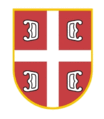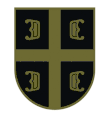Serbian Armed Forces
| Serbian Army | |
|---|---|
| Војска Србије Vojska Srbije | |
 | |
| Service branches | Land Forces Air Force and Air Defense Training Command |
| Headquarters | Belgrade |
| Leadership | |
| Commander-in-Chief | President Boris Tadić |
| Minister of Defence | Dragan Šutanovac |
| Commander of General Staff HQ | Lieutenant General Zdravko Ponoš |
| Personnel | |
| Military age | 18 |
| Active personnel | 38,000 ranked 79th |
| Expenditure | |
| Budget | 65 Billion RSD or 1.9 billion US $(2007)[citation needed] |
| Percent of GDP | 2.4% (2007) |
| Related articles | |
| History | Military history of Serbia |
| Ranks | Serbian military ranks and insignia |
The Armed Forces of Serbia (Serbian: Војска Србије or Vojska Srbije) is the organized armed force that defends the Republic of Serbia and conducts other missions with respect to the constitution and laws of Serbia.
The Serbian Armed Forces basic tasks include:
- Defending Serbia from armed foreign threats.
- Participating in the process of building and maintaining peace in the region and across the world.
- Providing support in case of natural disasters and other catastrophes.
Structure
The Serbian Army is organized at 3 levels: strategic, operational and tactical.
Forces are organized on strategic, operational and tactical level and into commands, units and institutions. It is basically constituted of arms, branches, services. The Arms represent integrated branches and services which have relatively limited autonomy in warfare at land, sea and air.
Army branches constitute: the infantry, armored units, artillery, engineering, air defense artillery missile units, aviation, navy, electronic reconnaissance and warfare.
Army services can be general and logistics.
General army services are: intelligence, security, liaison, informatics, nuclear-biological-chemical, air reconnaissance and reporting, geodetic, hydro meteorological and hydro-navigational and legal service.
Logistics services are: technical, procurement, medical, transport, vet, construction, and financial service.

The Armed Forces of Serbia consist of
Since Serbia was the dominant partner in the former union with Montenegro, it has inherited the considerable bulk of the army and air force after Montenegro declared independence in 2006. However, as Serbia is landlocked, Montenegro inherited the navy (Montenegro subsequently sold most of its naval equipment to other coastal countries) while Serbia was left with a flotilla which protects Serbian rivers and canals. For more see: River Flotilla of Serbian Armed Forces.
Units under direct command of Military General-staff
Serbian Land Forces
The Serbian Land Forces is the largest and the oldest army branch. Its organization, structure, armaments and equipment are tailored to activities conducted predominantly on the ground in its respectively assigned missions and tasks. Mani organization is based on Brigade/Battalion system. Land Forces compose from four land brigades, one combined-arms artillery brigade, and special brigade which is under command of Serbian Army General staff. There are also two military police battalions, NBCW battalion, signal battalion and river flotilla. The land forces brigades are main units of land forces and their duty is to defend their regions. Organization of LF Brigades is very similar, each compose from one command battalion, two infantry battalions, one tank battalion, two mechanized battalions, one self-propelled artillery battalion, one self-propelled rocket artillery battalion, one air defense battalion, one engineer battalion and one logistic battalion. Exclusion is the First LF battalion which have two pontoon instead of one infantry battalion. The combined-arms artillery brigade compose from three howitzer-cannon-artillery battalions, artillery rocket battalion and logistic battalion.
Serbian Air Force and Air Defense
The Serbian Air Force is the youngest and the most advanced branch encompassing branches and services whose organization, structure, armaments and equipment are tailored to perform combat activities in aerial targets and on the ground. It consists of about 3,000 active personnel and 170 aircraft in 2 main bases, Batajnica and Lađevci. Although largely neglected, the air force is currently begun mass modernization to bring it up to standards. Air force is organized on Air Base/Squadron system, and it consist from two air bases and 7 squadrons and 7 ground units. One fighter squadron is equiped with Soviet-made MiG-21 and MiG-29 fighters, one squdron with home-made J-22 Orao attack aircraft, one squadron with Utva 75 and Super Galeb trainer aircraft, one squadron with Gazelle Gama anti-tank helicopters, one squadron with Mi-8 and Gazelle helicopters and one squadron with An-26 cargo aircraft and Mi-8 transport helicopters. The Air defense is organized like ground forces on Brigade/Battalion system and it consist from one air defense brigade. The main air defense systems are Kub-M and S-125 Neva which will be modernized in next years. There are also one signal battalion, one engineering battalion and Center for Air Reconnaissance.
Training Command of Serbian Army
Key novelty in the organization of SAF is the establishing of the training command on 23 April 2007, by merging parts of Operation Forces,LF and Air Force units. This completes the merging of seven territorial centers for basic training and five centers for specialist training of the members of military arms, branches and services. In addition to the training centers, the Training Command also comprises training grounds and firing grounds.
Modernization
In late 2003, the Serbian Armed Forces began an ambitious task of mass modernization and reorganization of its entire structure. The first step of modernization was reorganizing all units and command structures to reduce the over all size of the army and make it more maneuverable and professional to respond to dangerous situations, this part of the reorganization plan was fully completed in under 13 months. The withdrawal of old and obsolete equipment and procurement of replacements is currently in the process. The Armed Forces are planning to move to a completely professional force and abolish conscription (very unpopular among young Serbian people) by 2010, operating at international standard (NATO) and participating in UN peacekeeping operations.
T-55 tanks and older logistical vehicles are currently in the process for being withdrawn and replaced. The withdrawn T-55s will be put on sale. T-72's will be used for training. A planned modernization of M-84 into M-2001 is also due. M-80A IFV's will be modernized to serve for a prolonged 10 years of service. The military has made plans to announce a tender for 200 8x8 wheel armored vehicles, likely choices are Patria AMV, BTR-90, Mowag Piranha or Pandur.[1]
There are plans to obtain around 30 or more new fighter aircraft to replace the aging MiG-21 fleet as well as J-22 that are due to retire around 2010 to the latest, although Serbia does plan to retain its remaining MiG-29s currently. Serbia is also designing its own missile/UAV system, the ALAS missile. Plans are also being made to obtain new transport helicopters and aircraft as well. The Air Force will also modernized all G-4 Super Galebs in to G-4M and replace Utva 75 trainers with new Lasta 95 aircraft.
The ministry of defense is expected to increase its budget in the following years providing assistance in the modernization of the air force. The Air Force will get 30 new multi-role fighters to replace MiG-21's, 20 new helicopters to replace Mi-8's, and 4 new transport/cargo aircraft to replace An-26's and An-2[citation needed].
Uniforms
Serbian army is using various camouflage patterns. In year 2001 M-02 was introduced, with updated "Hrastov List" and new KARST pattern, but only in some special units. M-03 style uniform and new MDU camouflage pattern was introduced in 2006 after a year of extensive testings.
High-tech material used on M-03 offers better water resistance, very low visibility in visible specter and when using thermal, photo sensory and opto-electronic detection equipment.
The new Serbian MDU camouflage pattern is a five-colour pattern, comprising black, chocolate brown, Grey-green and medium green swathes on a light green background. The shapes have been elongated horizontally, however — presumably to meet NATO requirements. But even today the most common pattern used is M-93, officially-"Hrastov List", commonly called "Jigsaw" or "Puzzle". This 5 colored pattern was produced with lots of variations but primarily in two shades. One towards brown (fall, no snow winter) and one in green (spring, summer).
Serbian Army also uses NATO Woodland pattern, black uniforms for special forces units, white winter camouflages and many other different camouflage and color uniforms.
As for now, M-MDU03 it's primarily worn by the officers, professional soldiers, army special forces as well by regular army stationed at the administrative Kosovo and Metohija border.
However, Serbian army has concluded that M-03 as well as MDU-03 camouflage doesn't meet requirements of Serbian army, and therefore it will not be issued as standard pattern. Serbian army is currently developing new combat, ceremonial, dress uniforms and digital pattern, which is expected to become a standard pattern in near future
-
The symbol of the Army used on dress uniforms
-
The symbol of the Army used on camouflage uniforms
-
Subdued version of national flag worn on camouflage uniform
-
Serbian flag with desert digital camouflage pattern
-
Variant of new digital camouflage pattern for Serbian Army
-
M-03, 3 color desert pattern.
Some official sources in the army are reporting new ceremonial and dress uniforms; there is also a project to digitize MDU and YPA(JNA) mountain sniper camouflage by the year 2010.
Peacekeeping operations
Currently peace keeping operations involving Serbian Armed Forces are located in the troubled regions of Africa. The Serbian Armed Forces has expressed wishes to continue its active participation in these peace keeping roles and to further expand them and ensure lasting peace world wide.
Current peace keeping missions:
 Liberia: (UNMIL) - 6 officers as military observers;
Liberia: (UNMIL) - 6 officers as military observers; Côte d'Ivoire: (UNOCI) - 3 officers as military observers;
Côte d'Ivoire: (UNOCI) - 3 officers as military observers; Democratic Republic of Congo: (MONUC) - 2 doctor-officers and 4 medical technicians
Democratic Republic of Congo: (MONUC) - 2 doctor-officers and 4 medical technicians
Gallery
-
Serbian soldiers on foot patrol.
-
Serbian army engineers.
-
Serbian snipers in ghillie suits.
-
Serbian M-84A MBT.
-
Army guard howitzers
-
Serbian female cadets.
-
Serbian J-22 Orao strike aircrafts.
-
Serbian Soko Gazelle helicopter.
See also
External links
Notes
- ^ http://www.politika.co.yu/detaljno.php?nid=51490 Друштво : Војска Србије набавља 200 оклопних транспортера : ПОЛИТИКА




